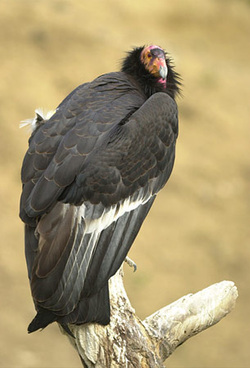Human Impact on the Chaparral
A California Condor - Now endangered as a result of human impact in the Chaparral
California's Chaparrals have been negatively impacted mainly by human development. Many trees, brush, and grasses, home to a variety of bird and animal species, have been cut down in order to supplement growing human populations in California. This poses a threat particularly to the biotic factors of the Chaparral, but have also influenced the abiotic factors by altering the native landscape.
As a result of such clearing, many nonnative plants have invaded the area. These invasive species are more flammable than the native plants, raising the risk for wildfires in the region. Many researchers used to believe the Chaparral was responsible for the creation spread of fires, but this has been proven false. Still, Chaparrals are frequently disregarded when fires erupt in California, as cities are oftentimes more concerned with extinguishing fires in more forested areas. These fires, when too frequent, easily destroy many Chaparral regions.
Other significant contributing human impacts on the Chaparral include the creation of water diversions, damming, and competition by invasive plant and animal species. Such events have led to the creation of many endangered species, such as the California condor (Gymnogyps californianus). However, restoration and protection efforts, such as the Draft Environmental Impact Statement and California Endangered Species Act, have been launched to help repair destroyed areas and restore native plant and animal life.

